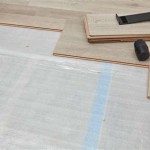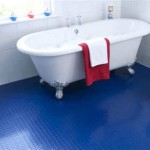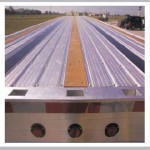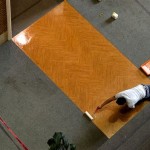Wide Hardwood Flooring vs. Narrow Width: A Comparative Analysis
The selection of hardwood flooring is a significant design decision impacting the aesthetic appeal, perceived space, and overall value of a residence or commercial property. Among the key factors to consider is the width of the planks. Two primary options dominate the market: wide plank hardwood flooring and narrow width hardwood flooring. These choices offer distinct advantages and disadvantages, influencing not only the visual impact of the space but also practical considerations like installation, cost, and maintenance. A thorough understanding of these differences is crucial for informed decision-making.
This article aims to provide a comprehensive comparative analysis of wide hardwood flooring and narrow width hardwood flooring. It will examine the aesthetic differences, installation processes, cost implications, structural considerations, and maintenance requirements associated with each type. By presenting a balanced overview of these factors, it seeks to equip readers with the knowledge necessary to choose the flooring option best suited to their individual needs and preferences.
Aesthetic Considerations: Scale, Style, and Visual Impact
The aesthetic impact of flooring is arguably the most immediately noticeable difference between wide and narrow planks. Wide planks, typically defined as planks wider than 5 inches, tend to create a more open and spacious feel, especially in larger rooms. The fewer seams across the floor visually expand the area, contributing to a sense of grandeur and continuity. This effect is further amplified when using longer planks, as the reduced number of end seams enhances the unbroken flow of the wood grain.
Conversely, narrow width planks, generally ranging from 2 to 4 inches, offer a more traditional and formal appearance. The increased number of seams creates a busier, more intricate pattern on the floor. This can be particularly appealing in smaller rooms, where the detail adds visual interest and prevents the space from feeling too plain. Narrow planks are often associated with classic architectural styles and period homes, aligning well with traditional décor aesthetics.
Style preferences also play a critical role in determining the appropriate plank width. Wide planks are frequently chosen for contemporary and rustic designs. Their clean lines and natural wood grain patterns complement minimalist interiors and farmhouse-style homes. Narrow planks, on the other hand, are better suited for more formal and traditional spaces, such as Victorian or Colonial-style houses. They can also be used to create intricate patterns, such as herringbone or parquet, adding a touch of elegance and sophistication to the floor.
The visual impact of wood grain is another important factor to consider. In wide plank flooring, the grain patterns of the wood become more prominent, showcasing the natural beauty and unique character of each plank. This can be particularly desirable for those who appreciate the organic variations and imperfections of natural wood. Narrow planks, with their smaller surface area, tend to exhibit less pronounced grain patterns, creating a more uniform and less visually striking appearance. The species of wood selected will further influence the aesthetic impact, with species like oak and hickory offering more pronounced grain patterns compared to maple or birch.
Installation Process: Complexity, Stability, and Subfloor Requirements
The installation process for wide and narrow plank flooring differs significantly, primarily due to the inherent structural properties of wide planks. Wide planks are more susceptible to expansion and contraction in response to changes in humidity and temperature. This dimensional instability can lead to gapping, cupping, or buckling if the installation is not performed correctly. Therefore, proper acclimatization of the planks to the room's environment prior to installation is crucial.
Subfloor preparation is also paramount when installing wide plank flooring. The subfloor must be perfectly level and free from any moisture issues. Unevenness in the subfloor can exacerbate the effects of expansion and contraction, leading to uneven flooring and potential damage. It is often recommended to use a self-leveling compound to ensure a perfectly flat surface. A moisture barrier is also essential to prevent moisture from seeping up from the subfloor and affecting the wood planks.
The actual installation methods also differ. Wide planks often require the use of specialized adhesives and fasteners to ensure a secure and stable bond to the subfloor. The adhesive must be specifically formulated for hardwood flooring and capable of accommodating the natural movement of the wood. In addition to adhesive, screws or nails may be used to provide extra holding power, particularly in areas prone to high traffic or moisture exposure. Some installations might require a mechanical fastening system designed to allow for expansion and contraction.
Narrow plank flooring, due to its smaller width, is generally less susceptible to dimensional instability and, consequently, the installation process is typically simpler. While acclimatization and subfloor preparation are still important, the tolerances are less stringent. The planks can be installed using a variety of methods, including nailing, stapling, gluing, or floating. Floating installations, where the planks are not directly attached to the subfloor but rather interlock with each other, are particularly common with narrow plank flooring, as they allow for natural expansion and contraction without affecting the stability of the floor.
The complexity of the installation process can also impact the overall cost. Wide plank flooring installations often require more time and expertise, leading to higher labor costs. Narrow plank flooring installations, being generally less complex, can be completed more quickly and efficiently, potentially resulting in lower labor costs. However, the cost of materials, such as adhesives and fasteners, can also vary depending on the chosen installation method and the quality of the products used.
Cost Implications: Material Pricing, Installation Expenses, and Long-Term Value
The cost of hardwood flooring encompasses several factors, including the price of the materials, the installation expenses, and the long-term value and maintenance costs. Wide plank hardwood flooring typically commands a higher price per square foot compared to narrow width planks. This is primarily due to the higher demand for wider planks, which are often sourced from older and larger trees. The increased scarcity and difficulty in producing wide planks contribute to their higher cost.
The species and grade of the wood also play a significant role in determining the price. Exotic hardwood species, such as Brazilian cherry or tigerwood, are generally more expensive than domestic species like oak or maple. Similarly, higher grades of wood, which exhibit fewer knots and imperfections, tend to be more costly than lower grades. The finishing applied to the wood (prefinished or unfinished) also affects the price, with prefinished options often being more convenient but potentially more expensive upfront.
Installation expenses, as previously mentioned, can also contribute significantly to the overall cost of hardwood flooring. Wide plank installations, due to their complexity, often require more time and specialized labor, resulting in higher labor costs. Additional expenses may include the cost of subfloor preparation, such as leveling or moisture remediation, as well as the cost of adhesives, fasteners, and other installation materials. Obtaining multiple quotes from qualified installers is essential to ensure a competitive price.
Long-term value and maintenance costs should also be considered when evaluating the cost implications of hardwood flooring. While wide plank flooring may have a higher initial cost, it can potentially increase the resale value of a home due to its perceived elegance and spacious feel. Well-maintained hardwood flooring can last for decades, providing a durable and aesthetically pleasing surface. The cost of maintenance, including regular cleaning, refinishing, and repairs, should also be factored into the overall cost analysis. Narrow plank flooring, while potentially less expensive upfront, may require more frequent repairs or refinishing due to the increased number of seams and its potentially less durable construction, depending on the quality of the wood and installation.
Ultimately, the choice between wide and narrow plank flooring involves a careful consideration of aesthetic preferences, installation complexities, and cost implications. Evaluating these factors in light of individual needs and circumstances is crucial for making an informed decision that will provide lasting satisfaction and value.

Narrow V S Wide Hardwood Planks Which One Is Ideal For Your Flooring Project Castle Bespoke

Standard Narrow Or Wide Solid Wood Flooring Jg Solihull

Wide Or Narrow Wood Flooring Direct

Wide Plank Vs Narrow Hardwood Flooring In Colorado

Wide Vs Narrow Plank Floors Which Should You Choose

Wide Or Narrow Wood Flooring Direct

40 Diffe Types Of Engineered Wood Flooring Plus Pros Cons And Cost

Wide Vs Narrow Plank Wood Floors Cameron The Sandman Flooring Contractor

Wide Vs Narrow Timber Planks What S The Best Option For Your Space Style Floor

Wide Vs Narrow Planks Of Flooring Ambience Hardwood
Related Posts








